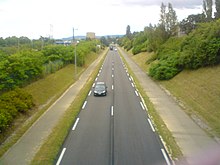Swiss customs territory
The Swiss customs area is the area in which the Federal Customs Administration (FCA) enforces the Swiss Customs Act. The Swiss customs territory differs essentially by Zollausschluss- and customs terminal regions of the national territory .
Exclusion Areas
The customs-free areas, the valleys Montague and Sampuoir are within the respective territory, but from historically derived geographical reasons outside the customs borders. Until the construction of a road that leads purely through Swiss territory, they could only be reached via Austrian territory.
The platforms of the Badischer Bahnhof in Basel are also exempt from customs duties . Unlike the station building, they do not belong to the Swiss, but to the German or EU customs area. The customs border is at the city-side entrance to the platform underpass.
Customs areas

The customs connection areas of Switzerland are areas of other countries, which are, however, regarded as part of the Swiss customs area. There are no customs controls at the border with Switzerland itself.
There are two such areas:
- The small state of Liechtenstein is completely part of the Swiss customs area. It has a common currency with Switzerland , the Swiss franc . They also have a common post office shelf and together form a customs union , although the Principality of Liechtenstein is a member state of the EEA . The border of the customs area exists here with Austria .
- The German municipality of Büsingen am Hochrhein ( district of Konstanz ) near Schaffhausen is an enclave in Switzerland, i. H. it is completely enclosed by Swiss territory. A state treaty has existed between the two countries since 1967 that regulates a number of details that arise from this situation. Cars from Büsingen, for example, are treated like Swiss vehicles, but must be cleared through customs if they are imported from Germany. Otherwise, Büsingen is largely integrated into the economic area of Switzerland.
The Italian municipality of Campione d'Italia ( Como province ) on the eastern shore of Lake Lugano is also an enclave in Switzerland. It is also strongly integrated economically in Switzerland. However, there is no international treaty here. The small territory was de facto Swiss customs territory until the end of 2019 . On January 1, 2020, Campione moved to the customs area of the European Union .
The reasons for these peculiarities are different. As a small country, Liechtenstein has an interest in economic links to larger markets in its neighbors and, after Austria's defeat in World War I , chose to move closer to Switzerland. At the Büsingen exclave of the EU state Germany, a customs border would be difficult to control and would entail economic disadvantages and complications for the population.
Duty Free Districts
Duty-free areas are customs airports. You belong to the customs area, but are treated as foreign customs . Bonded warehouses are since 1 May 2007 stops inches abroad, but part of the customs territory. The previous status regularly resulted in problems with the application of the remaining, non-customs federal law.
Duty Free Roads
Switzerland has three duty-free lanes , which enable road traffic in border regions without customs controls.
Basel Mulhouse Freiburg Airport - Basel
Swiss duty-free route across French territory: Basel-Mulhouse Airport , which is located on French territory, is connected to Basel ( Switzerland ) by a fenced-in toll-free route (Route Douanière) . The airport, a joint project between France and Switzerland, is the third largest Swiss airport. The road is also used by the airport bus (BVB line 50), which connects Basel SBB train station with the airport every quarter of an hour.
Geneva airport
Geneva Airport is connected to France by a toll free road. It enables goods to be forwarded without having to go through customs controls. They remain exclusively subject to the French / European procedures.
Weil am Rhein - Loerrach
Since the 19th century, the neighboring German communities of Weil am Rhein and Lörrach have been interested in a toll-free road running along the Wiese River across the canton of Basel-Stadt in the municipality of Riehen . The project was regulated in a state treaty between Switzerland and Germany in 1977, has been amended several times since then, but remained controversial because of a possible impairment of the last floodplain section of the river and difficult tectonic conditions on the «Schlipf» mountain section of the Tüllinger hill. As a result of several years of resistance and citizen protests, completion was delayed several times. The German toll-free route across Swiss territory was not built until 2006 and was provisionally opened to traffic on October 4, 2013.
See also
literature
- Sven Bradke: 75 Years Customs Treaty Switzerland-Liechtenstein: Anniversary letter on behalf of the Switzerland-Liechtenstein Society. Society Switzerland-Liechtenstein, St. Gallen 1998 ( series of publications by the Society Switzerland-Liechtenstein No. 8).
- Michael von Graffenried : Borders were created by people and are kept open by them. Swiss Federal Customs Directorate, Bern [1990].
- Thomas Klöti: The customs map of Switzerland (1825) by Johann Kaspar Zellweger and Heinrich Keller. The creation of a basis for the revision of transit and internal tariffs. In: Cartographica Helvetica Heft 14 (1996), pp. 25–34 ( full text ).
Web links
- Customs Act (ZG) of March 18, 2005 (as of May 1, 2007)
- State treaty with Liechtenstein
- State treaty with Germany
Individual evidence
- ↑ Article 3, Customs Act March 18, 2005
- ↑ EUR-Lex: inclusion of the Italian municipality of Campione d'Italia and the part of Lake Lugano belonging to the Italian territory into the customs territory of the Union
- ↑ Genève Aéroport: French air freight sector. Genève Aéroport, May 21, 2016, accessed on May 21, 2016 .
- ↑ The toll free route will open in both directions at the beginning of October. bz Basel, September 4, 2013, accessed October 3, 2013 .

